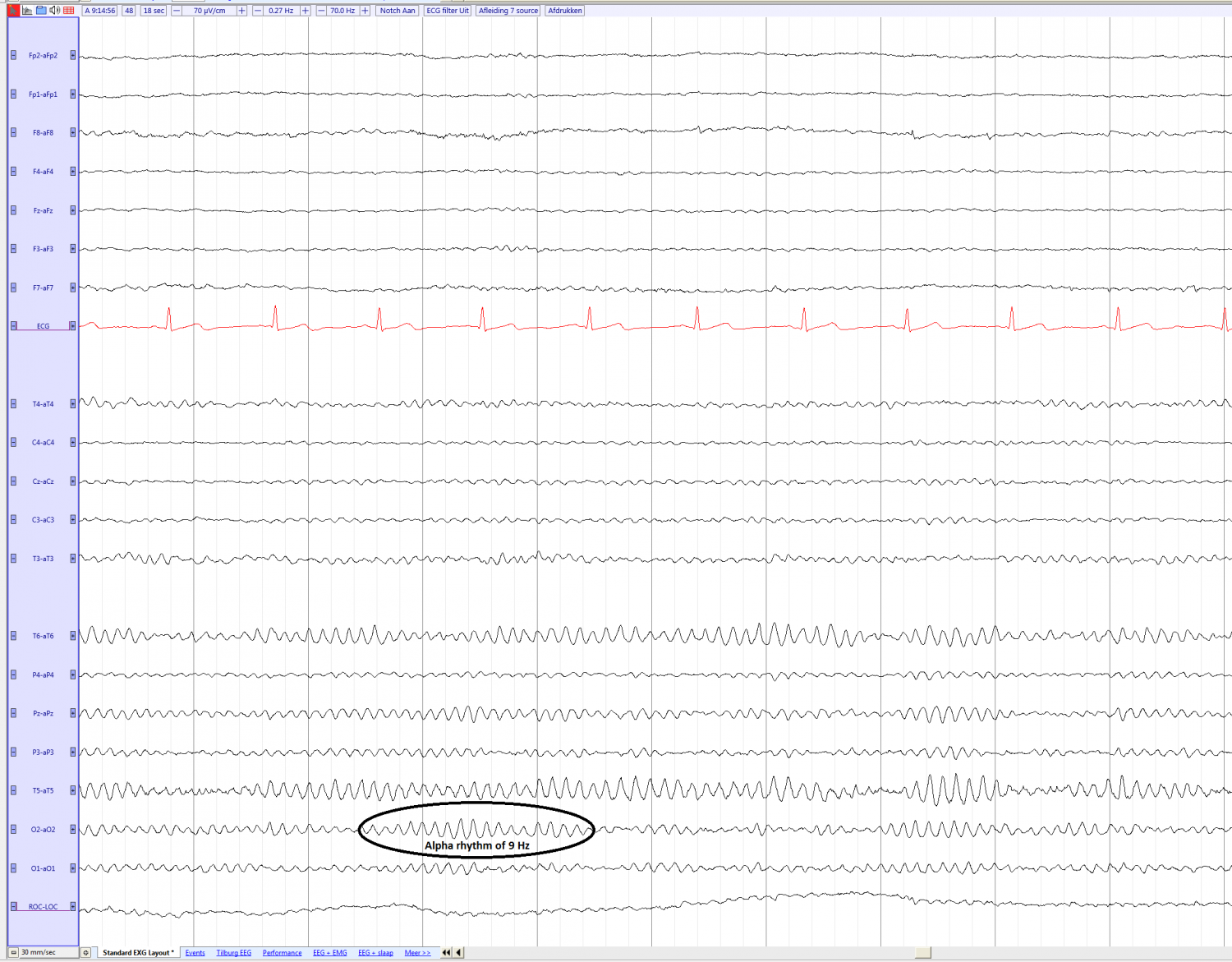Difference between revisions of "Alpha rhythm"
From EEGpedia
(Created page with "Alpha rhythm Frequentie: 8-13 Hz Posterior dominant Amplitude: 10-80 microV Suppressed with eyes open or mental tension") |
|||
| (28 intermediate revisions by 2 users not shown) | |||
| Line 1: | Line 1: | ||
| − | + | ||
| − | + | *Frequency: 8-13 Hz | |
| − | Posterior dominant | + | *Posterior dominant |
| − | Amplitude: 10-80 microV | + | *Amplitude: 10-80 microV |
| − | Suppressed with eyes open | + | *Wax and wane in amplitude |
| + | *Most prominent with eyes closed and relaxed | ||
| + | *Suppressed with eyes open, mental stress or sleep | ||
| + | *Left-right difference <1 Hz in frequency and <50% in amplitude (amplitude is usually higher on the right side) | ||
| + | *Alpha variants are normal sub- and supraharmonic frequencies of the alpha rhythm, particularly in children and young adults ([[Slow alpha variant]] and [[Fast alpha variant]]) | ||
| + | *2-5% of healthy people does not have a detectable alpha rhythm | ||
| + | |||
| + | |||
| + | *The posterior basic rhythm frequency is age dependent: | ||
| + | |||
| + | {| class="wikitable" | ||
| + | |- | ||
| + | ! scope="col"| Age | ||
| + | ! scope="col"| Frequency | ||
| + | |- | ||
| + | |0-3 months | ||
| + | |No posterior basic rhythm | ||
| + | |- | ||
| + | |4 months | ||
| + | |3-4 Hz | ||
| + | |- | ||
| + | |5 months | ||
| + | |5 Hz | ||
| + | |- | ||
| + | |1 year | ||
| + | |6-7 Hz | ||
| + | |- | ||
| + | |3 years | ||
| + | |8 Hz | ||
| + | |- | ||
| + | |7 years | ||
| + | |9 Hz | ||
| + | |- | ||
| + | |> 60 years | ||
| + | |Decrease by 0.08 Hz/year | ||
| + | |} | ||
| + | |||
| + | |||
| + | |||
| + | ---- | ||
| + | '''''Alpha rhythm of 9 Hz, posterior dominant with waxing and waning (source)''''' | ||
| + | |||
| + | [[File:Alpha rhythm average e.png|border|1500px|left]] | ||
| + | |||
| + | ---- | ||
Latest revision as of 16:45, 30 March 2017
- Frequency: 8-13 Hz
- Posterior dominant
- Amplitude: 10-80 microV
- Wax and wane in amplitude
- Most prominent with eyes closed and relaxed
- Suppressed with eyes open, mental stress or sleep
- Left-right difference <1 Hz in frequency and <50% in amplitude (amplitude is usually higher on the right side)
- Alpha variants are normal sub- and supraharmonic frequencies of the alpha rhythm, particularly in children and young adults (Slow alpha variant and Fast alpha variant)
- 2-5% of healthy people does not have a detectable alpha rhythm
- The posterior basic rhythm frequency is age dependent:
| Age | Frequency |
|---|---|
| 0-3 months | No posterior basic rhythm |
| 4 months | 3-4 Hz |
| 5 months | 5 Hz |
| 1 year | 6-7 Hz |
| 3 years | 8 Hz |
| 7 years | 9 Hz |
| > 60 years | Decrease by 0.08 Hz/year |
Alpha rhythm of 9 Hz, posterior dominant with waxing and waning (source)
